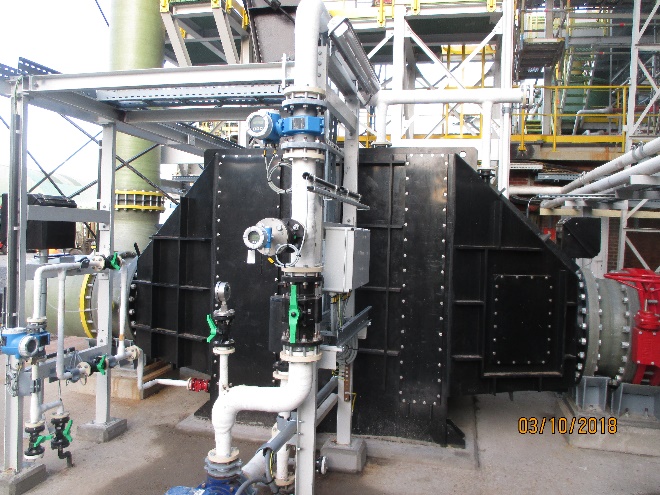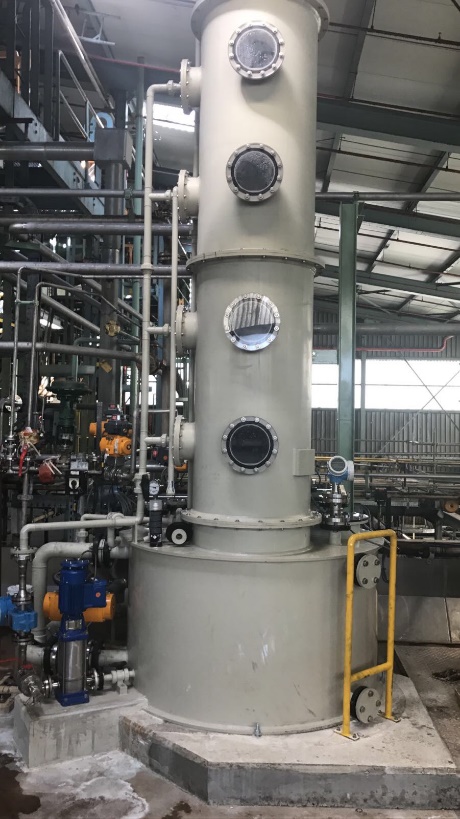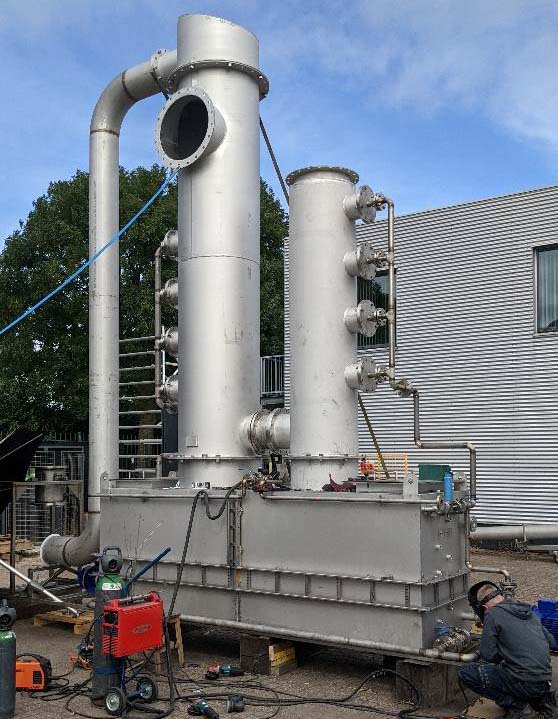
 In common chemical scrubber systems, the odor-contaminated or polluted gas is discharged or extracted to the scrubber by a centrifugal fan. The contaminated gas is passed through one or more horizontally or vertically executed chemical scrubber stages for treatment. The gas is passed through a packed bed or an open spray system where it is brought into very intense contact with the washing liquid containing chemical reagents. As with other absorption processes, the odor components or other chemical particles are first dissolved in the washing liquid and then react with the chemical additives.
In common chemical scrubber systems, the odor-contaminated or polluted gas is discharged or extracted to the scrubber by a centrifugal fan. The contaminated gas is passed through one or more horizontally or vertically executed chemical scrubber stages for treatment. The gas is passed through a packed bed or an open spray system where it is brought into very intense contact with the washing liquid containing chemical reagents. As with other absorption processes, the odor components or other chemical particles are first dissolved in the washing liquid and then react with the chemical additives.
The cleaned gas is then discharged through a chimney mounted behind the scrubber. The gas treatment can be conducted in multiple phases or washing stages, which is partly why the removal efficiency in a chemical scrubber can be more than 95%.
Scrubbers have been successfully used for many years as emission control systems that allow pollutants to be removed from host streams, with the pollutant particles occurring as gases, liquid droplets or solid (dust) particles. When multiple forms of pollutants are present in the very same gas stream, a scrubber is normally chosen for its ability to simultaneously remove gaseous contaminants. This process through gas-liquid diffusion gives the opportunity to eliminate liquid droplets and solid particles based on integration of the pollutants with the washing liquid and then separation based on mass inertia.
Mass transfer

 Mass transfer of divergent phases, or so-called liquid-gas integration, in a scrubber is the most important parameter for the efficiency of the scrubber. No further separation can be created without contact between washing liquid and the waste gas with the contaminants. In general, it can be stated that the larger the contact surface, the better the (washing) liquid-gas integration is realized. Of course, the time factor plays another significant role. It goes without saying that integration cannot take place properly if the staying time of the gas in the integration phase is too short.
Mass transfer of divergent phases, or so-called liquid-gas integration, in a scrubber is the most important parameter for the efficiency of the scrubber. No further separation can be created without contact between washing liquid and the waste gas with the contaminants. In general, it can be stated that the larger the contact surface, the better the (washing) liquid-gas integration is realized. Of course, the time factor plays another significant role. It goes without saying that integration cannot take place properly if the staying time of the gas in the integration phase is too short.
Scrubbers therefore vary in their capacity for mass transfer and separation of fraction. The configuration and design of scrubbers must be performed very carefully, with the biggest determining factors to be considered: the required and available mass transfer based on the contact surface, the pressure drop, required removal efficiency and finally the reliability of the installation.
The absorption efficiency is a function of the available contact surface for the exchange of the phases, and normally both an open-spray system scrubber and a packed bed scrubber can be designed to provide any desired removal efficiency.
A scrubber with a packing (e.g., Pall Rings, Raschig Rings) with a large exchanging surface give, generically speaking, an excellent integration of contaminants with the washing liquid. The disadvantage of packings with a large contact surface have a much higher pressure drop because, a large part of the so-called free volume in a packed bed is not available for gas flow and reclaims unusable volume and causes changes of directions of the gas flow that also increase the pressure drop. There are applications where this is acceptable, such as laboratory setups or small installations that do not operate continuously, so that the energy costs do not dictate a decisive role.
Scrubbers for large(er) flows or for contaminated gases containing a lot of dust (particles) or even sticky components are basically not suitable for packings with a large contact surface and because of that a small free volume. In addition to a large pressure loss, these packings mainly experience problems with contamination that can even lead to clogging or blockages. The solution of this problem can be realized by providing the scrubbers with an open spray system. An open spray system contains no packings and, on the contrary, has many nozzles that create so many droplets that the surface of all drops together can replace the contact surface of a packed scrubber. In addition, the energy potential of the droplets, due to their kinetic energy in relation to the gas velocity, ensures a huge integration process of liquid droplets with the contaminants in the gas. The pressure loss of an open spray system is much lower compared to a packed scrubber, remains unchanged low and has no problems with contamination, or even worse, clogging.
Distribution of washing liquid
The distribution of dust may consist of a system with box channel distributors with drainage holes and drainage pipes which are only used in combination with random packings (Pall Rings, Raschig Rings). The washing liquid is distributed over the entire surface and thus ensures a good distribution of the liquid so that the packings are well irrigated. The liquid can also be distributed over the packing using a pipe system with nozzles mounted on it which actually have the same function as the open distribution channels.
Scrubbers with an open spray system (i.e., without structured or random packings) must compensate the lack of reaction surface by means of a large spray surface. The specific nozzles that are used for this purpose generate a spray pattern with exceedingly small droplets which therefore generate an awe-inspiringly large contact surface.
Chemical dosing and water treatment

 The washing liquid is recirculated by means of a centrifugal pump which is connected on the suction side to the liquid buffer in which the washing liquid is stored. In certain areas where only (relatively) hard water is available, a water softener can be used for the makeup water. The hardness of the water has a major influence on the efficiency of the scrubber cleaning process. The washing liquid is recirculated and will be periodically sprayed based on certain parameters. The liquid level is then restored with fresh water. When this fresh water contains (a lot of) magnesium and calcium, this will lead to high concentrations of salts which will increase the hardness because with the discharge the salts will largely remain in the liquid buffer. This can be avoided when using a water de-ironing system. The alternative can be to discharge a lot of washing liquid, but this will then result in the water consumption becoming excessively high.
The washing liquid is recirculated by means of a centrifugal pump which is connected on the suction side to the liquid buffer in which the washing liquid is stored. In certain areas where only (relatively) hard water is available, a water softener can be used for the makeup water. The hardness of the water has a major influence on the efficiency of the scrubber cleaning process. The washing liquid is recirculated and will be periodically sprayed based on certain parameters. The liquid level is then restored with fresh water. When this fresh water contains (a lot of) magnesium and calcium, this will lead to high concentrations of salts which will increase the hardness because with the discharge the salts will largely remain in the liquid buffer. This can be avoided when using a water de-ironing system. The alternative can be to discharge a lot of washing liquid, but this will then result in the water consumption becoming excessively high.
Dosing systems with storage tanks, with adjustable membrane pumps for various chemicals, are also an indispensable part of the scrubber installation. The removal of soluble contaminants from the gas can be done by using only a lot of washing water as an open flush system. This means that the washing water is continuously discharged and refreshed and not pumped around. The contaminants will be absorbed into the water and then discharged through the drain. The water consumption associated with this is unjustified under the current (environmental) conditions and also unaffordable.
Another reason for applying chemicals in the washing water may be that contaminants are carried with the gas that are insoluble in water or are not degradable or, given their properties, should not be drained, and disposed. In these cases, it is necessary to add so-called additives to the washing water that react with the contaminants of the supplied gas. The choice of chemicals is determined by the nature of the contaminants but, can also be determined based on the customer's capabilities. It is not always permitted to simply supply chemicals, use them, and then dispose the residual products. In these situations, alternative cleansing agents should be added, or a modified configuration of the scrubber will have to provide a solution.
The chemicals are in general dosed directly into the washing water. As a result, we no longer talk about washing water but, about washing liquid. The recirculated washing liquid is brought into contact with the contaminants in the gas where they are captured and then jointly drop back into the liquid buffer. The content of the liquid buffer is determined by the reaction rate or half-life of the impurities in the washing liquid. In general, it can be stated that a slow response requires a large system content. The intention is that the reaction has been conducted as much as possible into a stable residual product before the washing liquid is brought back into contact with the polluted gas via the recirculation by the pumps. If the reaction is not fully or sufficiently advanced, there is a real risk that contaminants can be released back into the gas.
In addition, in the event of a reaction that has not been fully impinged, additional problems may arise at varying concentrations of the contaminants in the gas. The pollutant gases present in the washing liquid, prefer to be in balance with the concentration of pollutant gases in the entrained gas stream. This phenomenon is described in Henry's Law regarding the phenomena of the equilibrium situation of (gas) concentrations.
Dosing chemicals will eventually have to lead to a breakdown of harmful contaminants or a transformation into harmless components that can be easily disposed of and processed. Secondly, accurate dosing with the right chemicals prevents extreme water consumption.
Indirect emission control based on washing liquid monitoring

 The quality of the emitted gas can be conducted in diverse ways. The most common principle is based on monitoring the quality of the washing liquid. This is a good method as the quality of the washing liquid is directly proportional to the quality of the emitted gas. Before the correlation between the limit value of the gas in relation to the washing liquid is determined, it is often necessary to experiment with the settings of the washing liquid during the adjustment period. Once the limit values have been established with the emission measurements or sampling of the gas, the scrubber can be put into operation permanently. The contaminants in the waste gas and the chemicals used to enable the scrubber to function correctly, determine the choice of instruments (sensors for the washing liquid) that should be used. The acidity of the washing liquid is determined using a pH measurement, in addition, a conductivity measurement is often used for quality which determines the drain. In addition, a free chlorine measurement is often used to determine the reaction of the washing liquid in the buffer, whether in combination with an ORP measurement for the reaction velocity.
The quality of the emitted gas can be conducted in diverse ways. The most common principle is based on monitoring the quality of the washing liquid. This is a good method as the quality of the washing liquid is directly proportional to the quality of the emitted gas. Before the correlation between the limit value of the gas in relation to the washing liquid is determined, it is often necessary to experiment with the settings of the washing liquid during the adjustment period. Once the limit values have been established with the emission measurements or sampling of the gas, the scrubber can be put into operation permanently. The contaminants in the waste gas and the chemicals used to enable the scrubber to function correctly, determine the choice of instruments (sensors for the washing liquid) that should be used. The acidity of the washing liquid is determined using a pH measurement, in addition, a conductivity measurement is often used for quality which determines the drain. In addition, a free chlorine measurement is often used to determine the reaction of the washing liquid in the buffer, whether in combination with an ORP measurement for the reaction velocity.
Emission control with an analyser
A direct, exceptionally reliable control of the emission can be conducted using a specific analyzer. The analyser is mounted in the discharge behind the scrubber and immediately measures the presence of the remaining contaminants in the gas. The nature of the impurities determines the choice of the analyzer; here a distinction is made between dust analyzers and specific gas analyzers. In the case of online dust analysis, a probe is used, if possible, that provides a direct readout for the total dust concentration.
The gas analyzers measure online with a reading in ppm. With an extractive measurement, a form of sampling conditioning is always required because of, for example, the high gas temperature or a high-water concentration. The preference of using an analyzer to check the emissions of a scrubber installation is the fact that the emission value is directly readable. Based on the measured value, the drain of the scrubber can be activated so that the quality of the washing liquid is directly controlled. At the same time, the user of the installation, the permit provider and the environmental service know the emission values under all circumstances and no emission exceedance will take place because of the direct measurement method.
Construction of the scrubber

 When designing and manufacturing the scrubbers, Ravebo considers factors such as material, construction, foundation and support, material thickness, maximum corrosion resistance for interior and exterior surfaces, to ensure a long service life, and access hatches or manholes for maintenance and inspection. Unilaterally, plastic as a construction material offers low weight and good corrosion resistance, low operating costs and a long service life, but on the other hand this is not suitable for high(er) temperatures. With respect to applications of chemical scrubbers, in most cases a suitable stainless steel will be chosen which, apart from the benefit of a low weight, also has all the positive characteristics for an exceedingly long service life. The construction and construction of the scrubber installations are such that in the event of future emission adjustments, the scrubber can be expanded or adapted easily without major investment. A completely new scrubber installation is then not necessary.
When designing and manufacturing the scrubbers, Ravebo considers factors such as material, construction, foundation and support, material thickness, maximum corrosion resistance for interior and exterior surfaces, to ensure a long service life, and access hatches or manholes for maintenance and inspection. Unilaterally, plastic as a construction material offers low weight and good corrosion resistance, low operating costs and a long service life, but on the other hand this is not suitable for high(er) temperatures. With respect to applications of chemical scrubbers, in most cases a suitable stainless steel will be chosen which, apart from the benefit of a low weight, also has all the positive characteristics for an exceedingly long service life. The construction and construction of the scrubber installations are such that in the event of future emission adjustments, the scrubber can be expanded or adapted easily without major investment. A completely new scrubber installation is then not necessary.